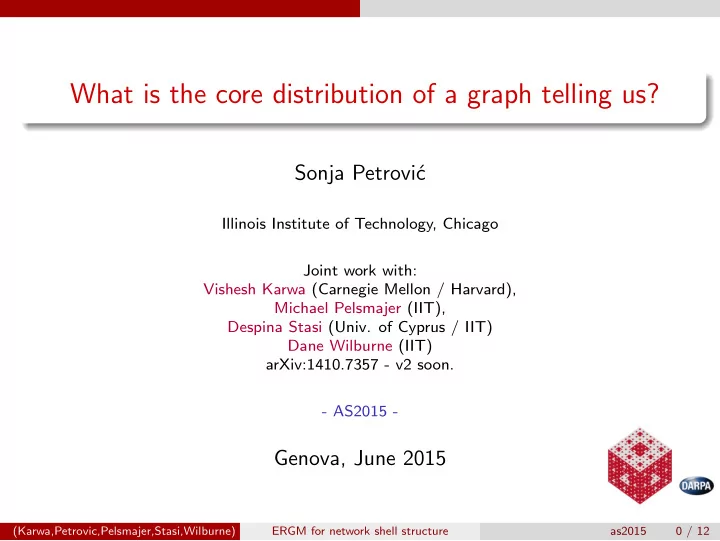

What is the core distribution of a graph telling us? Sonja Petrovi´ c Illinois Institute of Technology, Chicago Joint work with: Vishesh Karwa (Carnegie Mellon / Harvard), Michael Pelsmajer (IIT), Despina Stasi (Univ. of Cyprus / IIT) Dane Wilburne (IIT) arXiv:1410.7357 - v2 soon. - AS2015 - Genova, June 2015 (Karwa,Petrovic,Pelsmajer,Stasi,Wilburne) ERGM for network shell structure as2015 0 / 12
Motivation: Degree-centric models not enough for statistical network analysis Setting: statistical models for random graphs How to capture node importance? In some applications, it matters not just to how many other nodes a particular node in the network is connected, but also to which other nodes it is connected. → Is degree-centric analysis suitable? ← Examples: information dispersal, the spread of disease or viruses, or robustness to node failure... Social network setting: record ’node celebrity status’. (Karwa,Petrovic,Pelsmajer,Stasi,Wilburne) ERGM for network shell structure as2015 1 / 12
Motivation: Degree-centric models not enough for statistical network analysis Setting: statistical models for random graphs How to capture node importance? In some applications, it matters not just to how many other nodes a particular node in the network is connected, but also to which other nodes it is connected. → Is degree-centric analysis suitable? ← Examples: information dispersal, the spread of disease or viruses, or robustness to node failure... Social network setting: record ’node celebrity status’. (Karwa,Petrovic,Pelsmajer,Stasi,Wilburne) ERGM for network shell structure as2015 1 / 12
Discrete math tool: Cores decomposition of a graph Classifying vertices: coreness (a.k.a. shell index) [Seidman83]: A k -core decomposition of a graph captures precisely this: Any vertex may live in many cores, but only one shell. Vast literature on: Fast computation of shell indices; Interesting applications and heuristic studies. Not surfaced in stats literature so far: A rigorous statistical model for networks relying on core structure. → Core structure is summarized by shell distribution. ← (Karwa,Petrovic,Pelsmajer,Stasi,Wilburne) ERGM for network shell structure as2015 2 / 12
The ERGM: Shell distribution as sufficient statistic The shell distribution model. G = g : a random instance of a graph on n nodes n i ( g ): number of vertices in shell i ; p i : the “shel parameter” n − 1 � p i n i ( g ) P ( G = g ; p ) = ϕ ( p ) i =0 Exponential family form n − 2 � P ( G = g ; p ) = exp { n i ( g ) θ i − ψ ( θ ) } . i =0 Shell �↔ degree distribution: Erd¨ os-R´ enyi not a formal submodel Log-linear structure only on ‘atomic level’. (Karwa,Petrovic,Pelsmajer,Stasi,Wilburne) ERGM for network shell structure as2015 3 / 12
Recommend
More recommend